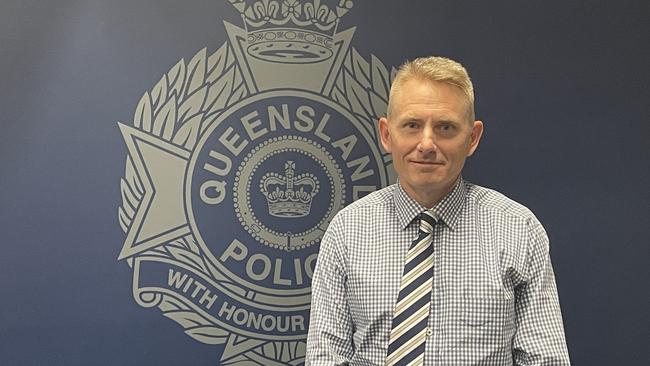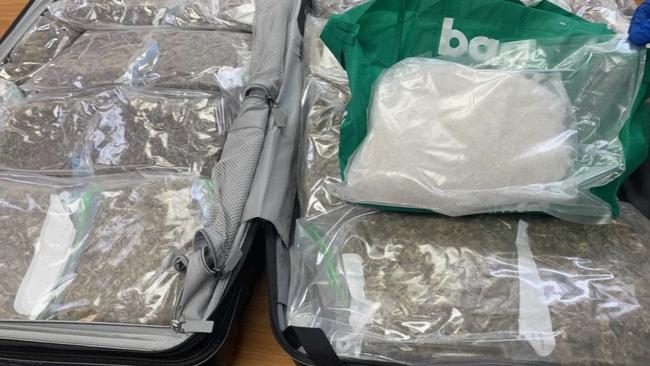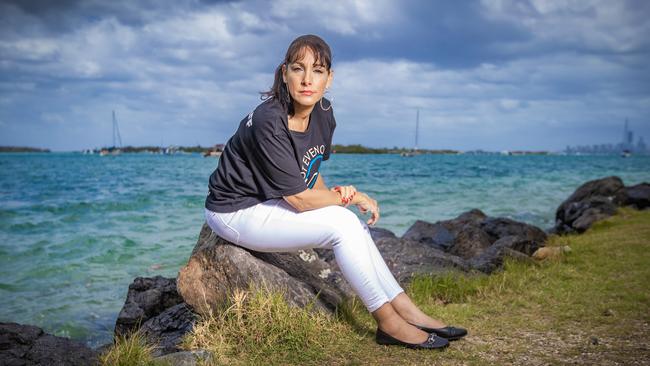Revealed: The trends behind Queensland’s rising meth problem damaging our streets
More than $105 million has been injected into Queensland’s meth infestation but the drug ice continues to plague our streets with consumption spiking by 46.5 per cent in just two years. FULL REPORT, ANALYSIS
Local
Don't miss out on the headlines from Local. Followed categories will be added to My News.
Queensland’s ice problem has soared with consumption spiking by 46.5 per cent in just two years despite the State Government’s five-year, $105 million plan to tackle the scourge.
Addiction groups are urging the government to “stop having conversations about it and actually be proactive” in tackling the issue, which is destroying average Queensland families, clogging the court system and using precious hospital resources.
Statistics from the Australian Criminal Intelligence Commission’s (ACIC) National Wastewater Drug Monitoring Program show meth consumption has increased by 46.5 per cent from its report during the height of Covid-19 between April and August, 2020.
And the surge in ice use has contributed to a significant number of hospitalisations, with Brisbane, Moreton Bay, and Somerset emergency departments currently treating more patients for methylamphetamine-related reasons than any others across the state.
The Queensland Government developed the Action on Ice initiative in 2016 following a summit to address increasing drug use.
Led by Premier Annastacia Palaszczuk, Police Minister Mark Ryan and then Health Minister Steven Miles, millions were dished out to reduce supply, demand and harm from ice.

But now Queensland’s top drug cop, Detective Inspector Bradley Phelps from the state’s Drug and Serious Crime Group, is warning of an impending meth invasion.
Det Insp Phelps said the latest police stats indicated declining drug use trends from April to June this year in Queensland and nationally.
However, methylamphetamine was an exception, increasing back towards pre-Covid levels.
He said meth “doesn’t discriminate” and had infiltrated even the ritziest parts of Queensland.
“When you talk about meth users, unfortunately it’s in every area of the state,” he said. “There’s no community within Queensland that hasn’t been impacted by the effects of methylamphetamine.”
Det Insp Phelps said the meth consumed in Australia was rarely produced here but was the work of organised crime syndicates, who target this country because of the lucrative drug market and the prices people were willing to pay.
The cost of meth in Australia is significantly higher than other areas of the world with the drug costing $80 for 0.1g, compared to $35 in the United Kingdom, $12 in the US and $8.50 in Europe.
“It’s certainly more prevalent in that younger demographic but no one is immune to the addictive effects of dangerous drugs particularly ice or crystallised methylamphetamine,” he said.
“The addictive qualities of that drug are very, very high and once people commence using it it’s a very short span of time before they become addicted to the drug and that obviously leads to it overtaking their life.

Det Insp Phelps said the Queensland Police Service had numerous operations targeting the trafficking and production of methylamphetamines, which included partnering with other organisations such as Australia Post tackling the movement of drugs through the mail.
ACIC’s most recent six-month report in October shows from December 2021 to April this year most regional sites in Queensland had above average consumption of methamphetamine.
The average consumption levels for regional sites in Queensland during this time was 1200mg per 1000 people per day, a 20 per cent increase from the report which covered April to August, 2020 where the average was 1000mg.
Most recent consumption levels at capital city sites where also higher with an average of 900mg per 1000 people per day, compared to 520mg from two years ago - a 73 per cent increase.
The report also showed the numbers have almost returned to pre-Covid levels with the consumption averages eclipsing the numbers from ACIC’s first report in 2017, where the regional average was 1100mg and the capital city average was 750mg.
At first glance meth-related emergency presentations appear to have dropped with 1648 in 2017/18 reduced to 418 in 2021/22.
But experts argue this number is skewed because of the Covid-19 pandemic.
Police Minister Mark Ryan told News Corp while progress had been made since the summit he acknowledge so much more still needed to be done.
“Issues around dangerously addictive substances are complex, especially from a physical and mental health perspective,” Mr Ryan said.
“The Queensland Police Service will continue to relentlessly target those who traffic drugs and seek to profit from the misery of others.”

Health and Ambulance Services Minister Yvette D’Ath said the Palaszczuk Government’s Action on Ice plan has been effective in addressing the harms caused by methamphetamine.
“A suite of initiatives have been implemented as a result of the Action on Ice plan,” she said.
Some of those initiatives include investing $14.3 million over three years for a 42-bed residential drug rehabilitation and treatment facility in Rockhampton and $43 million over five years to enhance specialist alcohol and other drug services.
In October, the Palaszczuk Government launched a landmark five-year health plan targeting mental health, alcohol and drug addiction treatments.
The Achieving balance: The Queensland Alcohol and Other Drugs Plan 2022–2027 and the Better Care Together – a plan for Queensland’s state-funded mental health, alcohol and other drug services to 2027 will work in consultation as part of a $1.645 billion investment in mental health treatment.
Better Care Together will have a strong focus on addressing the health inequities experienced by First Nations peoples and communities while Achieving Balance is a whole-of-government plan developed by the Queensland Mental Health Commission to reduce alcohol and other drug related harm and improve outcomes for individuals and families impacted by substance use
Australian Anti Ice Campaign CEO, and reformed addict, Andrea Simmons of the Gold Coast said the government had in the past been “right on the mark” when it came to making a plan to tackle the country’s methamphetamine epidemic – but the problem lay in its inaction.

“They keep bringing new summits and new queries and the problem continues to rise,” she said.
“They need to stop having conversations about it and actually be proactive about it.”
The director of Brisbane private hospital Hader Clinic Queensland Mel Symon echoed Ms Simmons’ sentiments, stating she certainly had not seen a reduction in the number of people taking up methamphetamine since the government released its plan.
In fact, she had seen a surge in the drug’s prevalence – particularly among younger people.
“Addiction is a coping mechanism,” she said.
“And (ice) is quite an affordable substance for most people to access.“Sometimes buying a couple of grams of ice is cheaper than buying a carton of beer.”
Shadow health minister Ros Bates also said the Palaszczuk Government had failed to stop the scourge of ice seeping further into our communities with a nine-percentage-point increase since 2017 of children in care whose parents use meth.
“We know the devastating impact ice has on families, with around 40 per cent of children in care having parents with current or previous methamphetamine use,” she said.
“This is a substantial increase from 31 per cent.”
Counselling, treatment and referral services
If you are concerned about your own or someone else’s drug use, call Alcohol and Drug Information Service on 1800 177 833. Help is free, 24/7, anonymous, and confidential.
Further assistance can be found in Family Drug Support online and by phone on 1300 368 186.
Free and 24/7 counselling for people using drugs, their family members and friends, can be accessed here.
METH CLOGGING UP COURT
Since November, News Corp reporters attended 67 court proceedings for serious meth-related crimes and almost three-quarters of those were in QLD, with 35 male offenders and 14 female offenders, aged 20 to 55.
They included Nanango’s Keith Norman Middleton, 23, whose meth-fuelled car crash left him with critical brain injuries and a lifelong driving ban; Logan woman Paige Mallard, 25, who was charged with 99 offences spanning three years; Mongols bikie Haydn Forbes, 26, who is currently in custody for the alleged murder of Gold Coast bikie Shane Bowden and Beenleigh’s Tristan Michael Black, 42, who faced 29 charges, including two counts of carnal knowledge with a 14-year-old girl.
Further north Gladstone’s Zoie-Jane Collins, 27, claimed her drug use was exacerbated after her daughter was badly burned in a fire pit accident; Townsville man Leslie Gordon Sharp, 55, was caught with $1.9 million worth of meth in the spare tyre of a car.
Sharp had previously been sentenced to 17 years’ jail in 1999 for attempted murder, sexual assault, and deprivation of liberty, and was this month sentenced to 11 years’ jail, with parole eligibility in November 2026.
QLD HOSPITALS WHERE METH IS MOST PREVALENT
The recent surge in ice use among Queenslanders has contributed to a significant number of hospitalisations, with Brisbane, Moreton Bay, and Somerset emergency departments currently treating more patients for methylamphetamine-related reasons than any others across the state.
A total of 418 presentations to Queensland emergency departments were related to methylamphetamine in the most recent financial year. Almost half — 46 per cent — of those were in the Metro North region.

Central Queensland and Darling Downs hospitals saw the second and third most methylamphetamine-related emergency department presentations in 2021-22 at 51 and 41 respectively.
Queensland Health data indicated the patients who presented to emergency departments in 2021-22 for methylamphetamine-related reasons were mostly men — specifically men aged between 30 and 40, and between 20 and 30 — as has long been the case.
But the gap between the number of female patients and male patients is much smaller today than it used to be.
Queensland Police Service had numerous operations targeting the trafficking and production of methylamphetamines, which included partnering with other organisations such as Australia Post tackling the movement of drugs through the mail.
Police have made several significant seizures in the past year, which included a man being charged after officers intercepted a truck containing more than $7 million worth of meth at Yatala in December, 2021.
He said a major focus for police was on hitting the crime syndicates, who produce these dangerous drugs, where it hurts most - in the pocket.
“There’s a real opportunity for us to really target the wealth acquired by these syndicates and take away the wealth they’re in the trade for,” he said.
“If we can do that, we can really impact the availability of drugs on the street and hopefully over time, try and remove or reduce the number of people who are addicted.”
Det Insp Phelps said police continued to invest significant resources into investigating syndicates and individuals involved in the distribution of methylamphetamine and other illicit drugs in our community.
“But there is more work to be done and law enforcement is only one aspect of dealing with the problem.”




